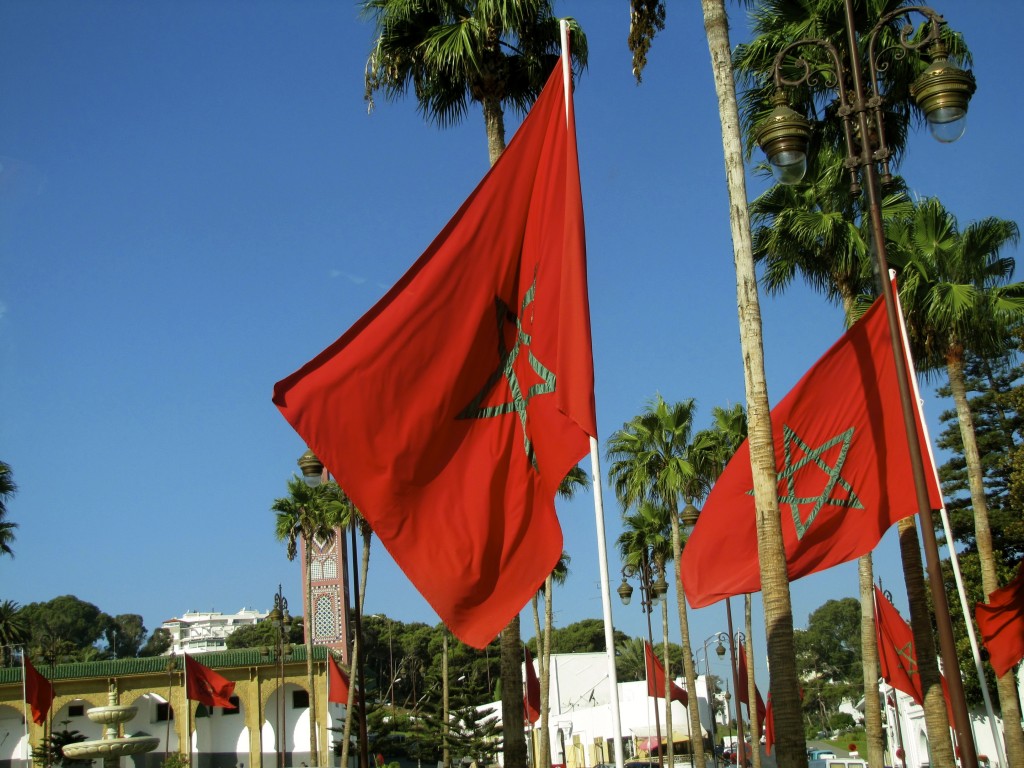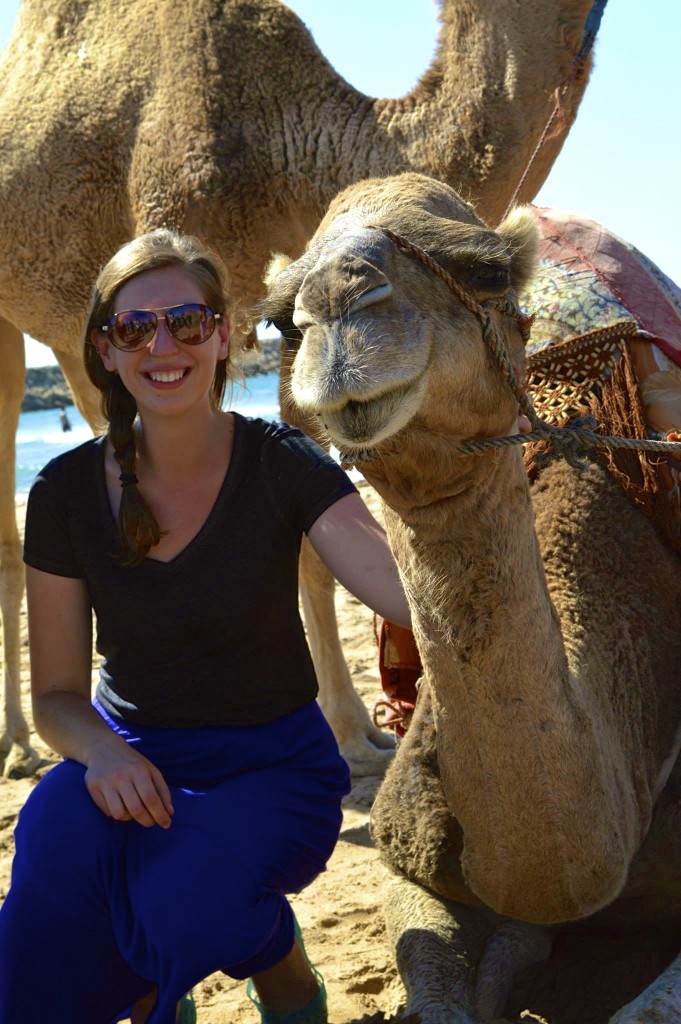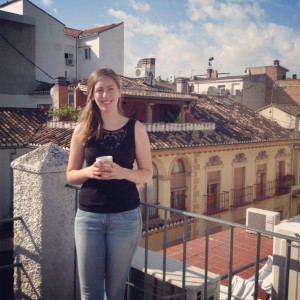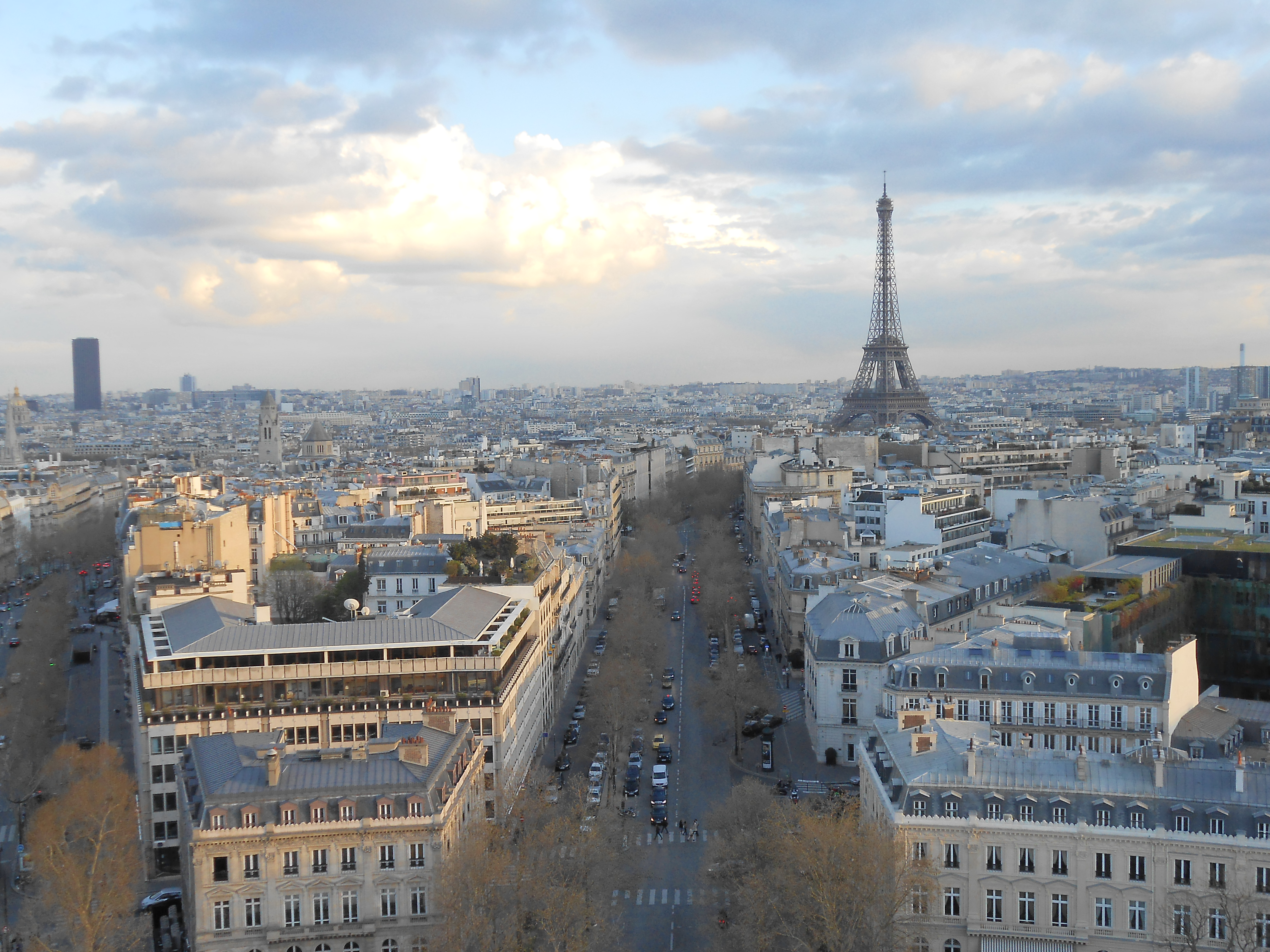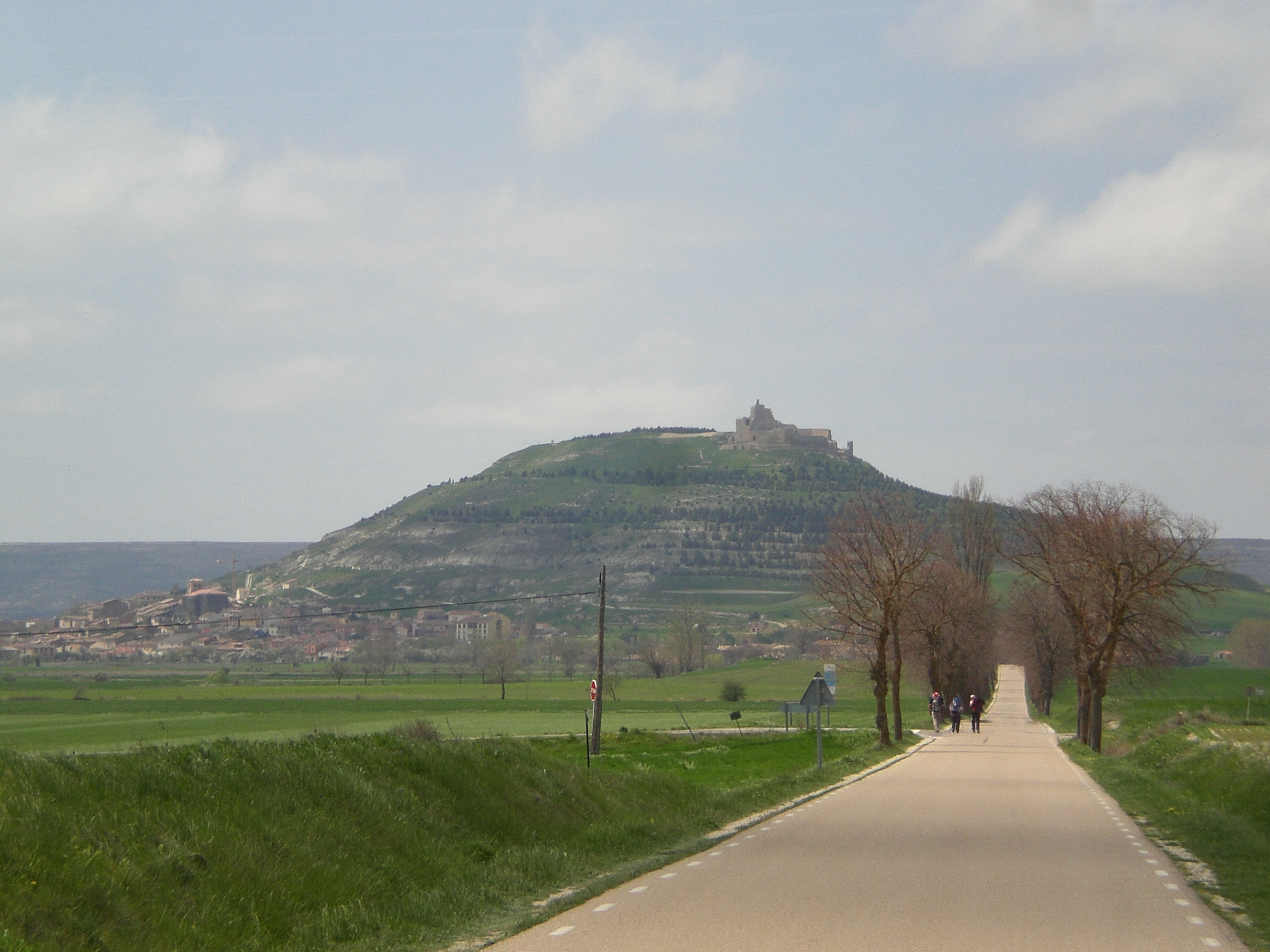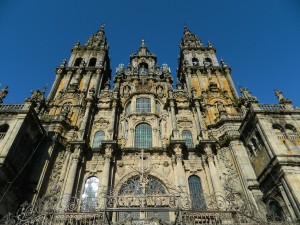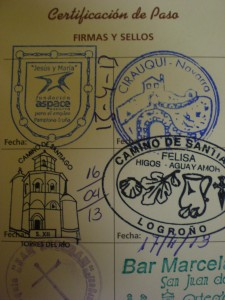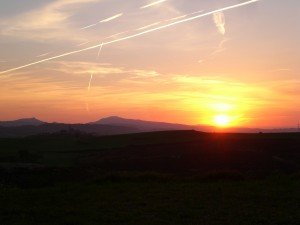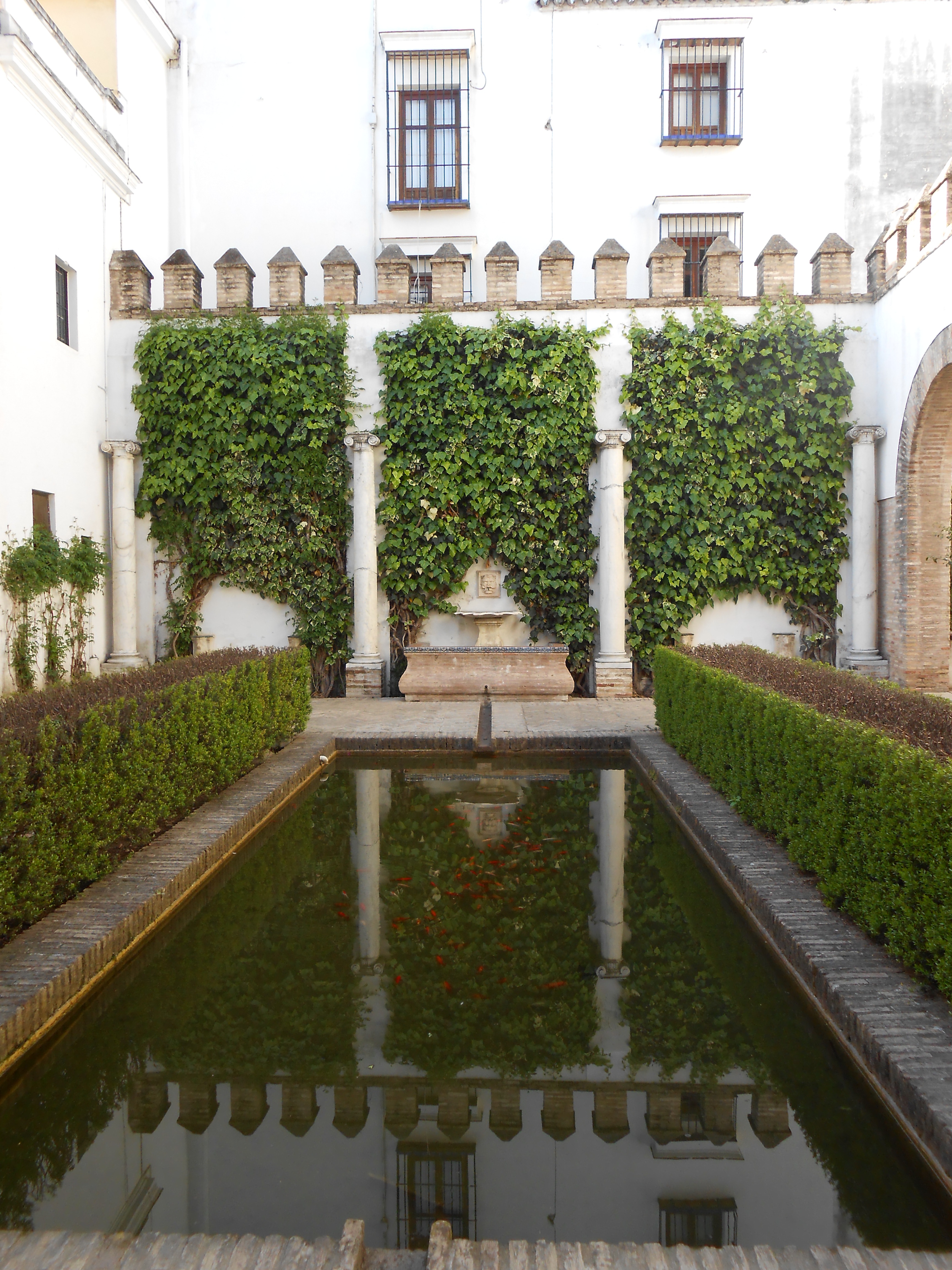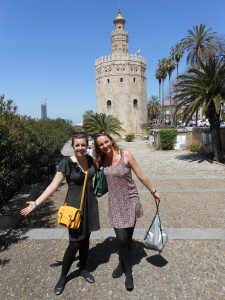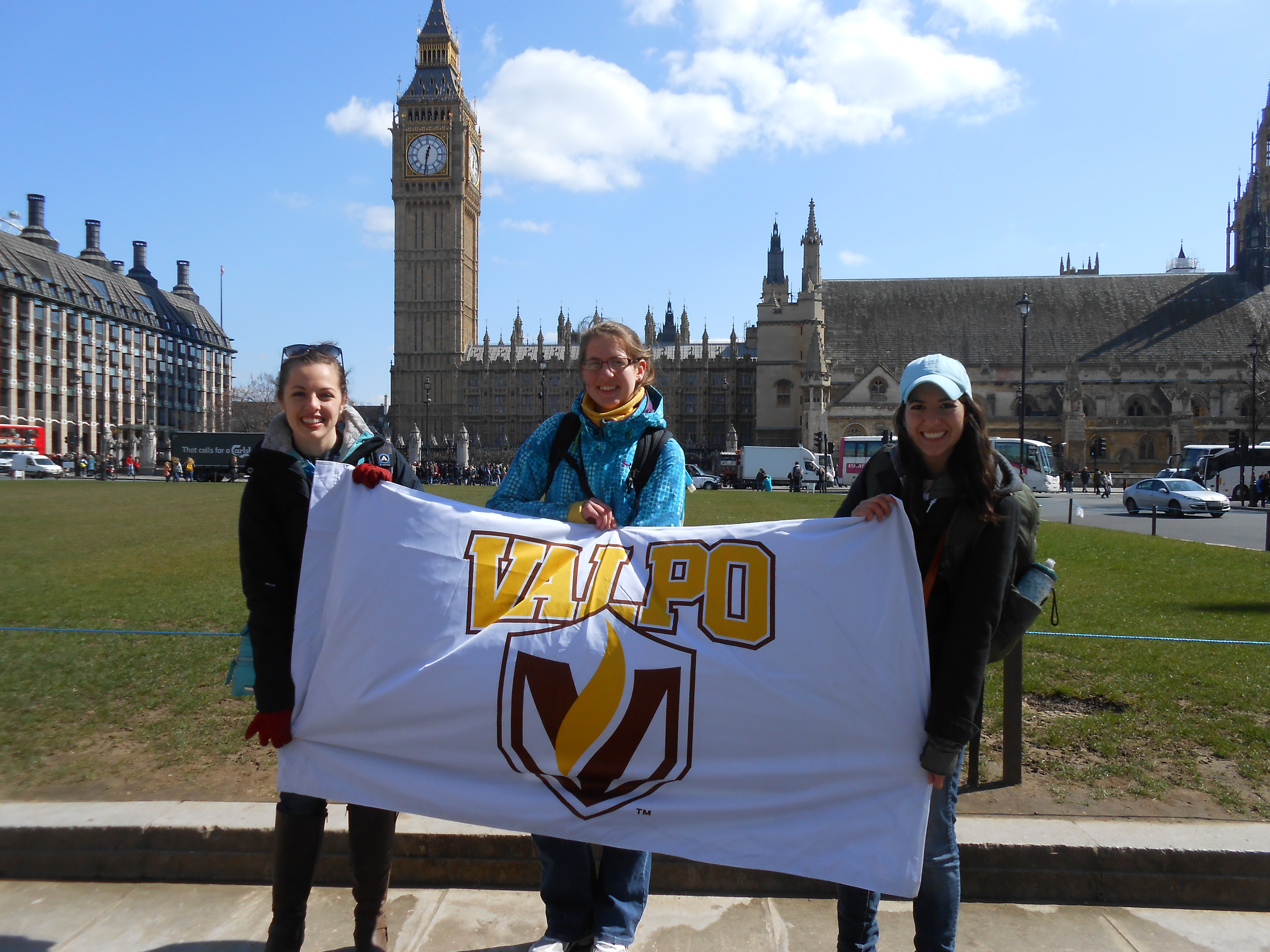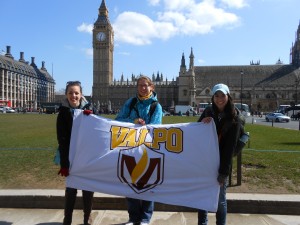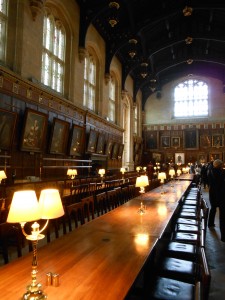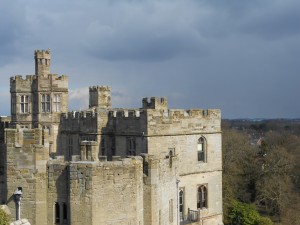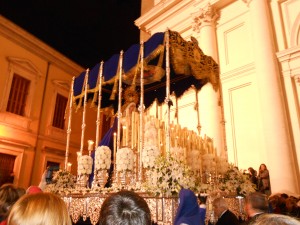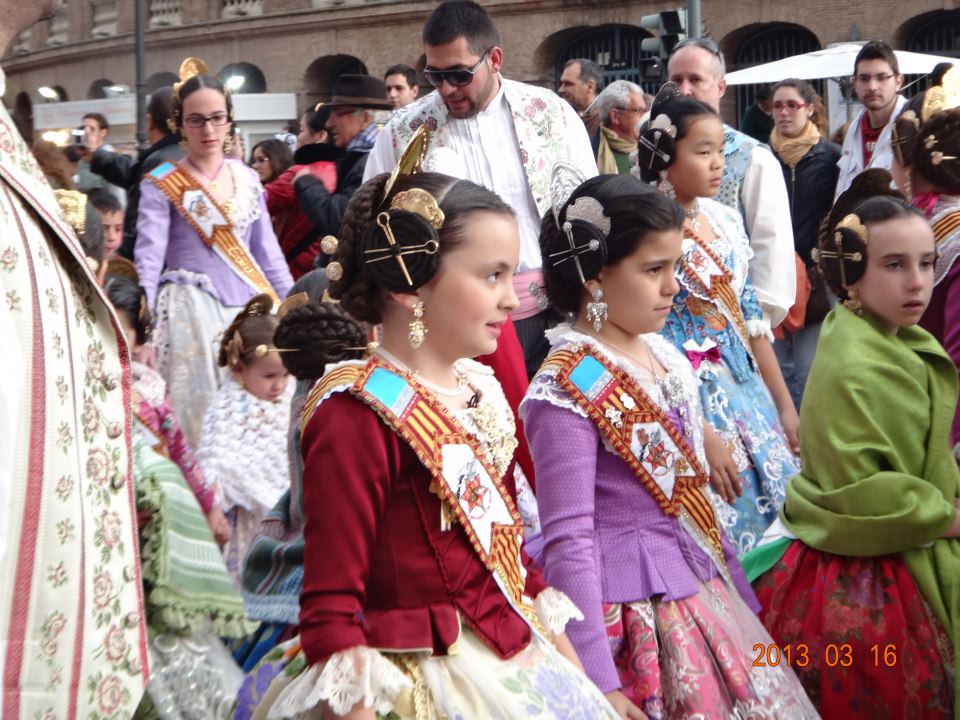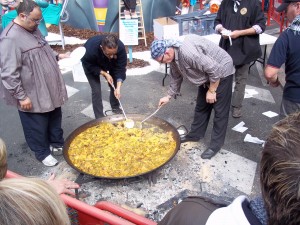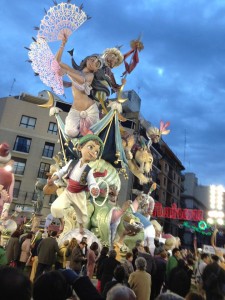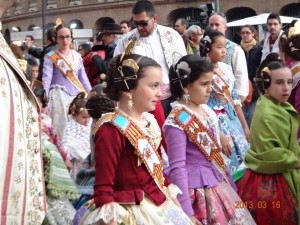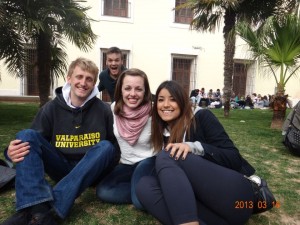In order to give you guys a better look into my trip to Morocco, I put together a video of my host mom, the camel rides, and a ton of other fun stuff. Click the link below, check it out, and make sure to read my full blog post about my Moroccan expirience!
Valpo Voyager
Student Stories from Around the World
Category: Spain (page 5 of 9)
About a month after my return, I think that it’s finally about time to tell you all about my trip into the heart of Africa. Ok, maybe “the heart of Africa” isn’t exactly the appropriate term for Morocco (both geographically and culturally speaking). Actually, it was more like being thrown into the streets of Aladdin’s Agrabba minus the Arabian Nights theme playing in the background. I kid you not, I saw at least 5 people sporting Aladdin theme notebooks/shirts while we were there. In all seriousness though, the trip was very impactful and one that I will not soon forget.
I had never anticipated visiting Morocco in my lifetime. Nor had I particularly wanted to. That is, until I read more about the Granada program and realized that a trip there was included in the cost. Suddenly, a trip to a country I had never desired to go to became one of the main reasons for choosing where I spent a year of my life. Crazy how that works. Fortunately, the trip lived up to the hype I had created for it. Though (almost) everyone else was just as pumped as I was about this journey, I think that in a lot of ways I had a very different trip than them simply because of some of the knowledge I had going into the 4 days I spent there.
Previous to going, I had a class on Modern Middle East history with the delightful Professor Schaefer. Though not always on topic, he shared so many stories of actually living and traveling within the Middle East and Africa, and as a consequence, broke a lot of previous misconceptions that I didn’t even know I had about the culture and people there. (Side note, if you haven’t read the book Ramza, do it. Now. Go spend the $5 and order it off of Amazon. It’s a fast read and I promise you won’t regret it.) I think that having that base of knowledge really allowed me to come into this trip with fresh eyes and an open heart. (See guys, education really does make a huge difference! I’ll get back to that thought when I post on Teach for America eventually….)
The tour group we went with was actually much less a tour group and much more an educational experience. Most of our guides had spent a lot of time in Morocco, could speak the language, and were personally connected and invested as a whole. As a result, we got to interact with the local culture on a level much deeper than your average sight-seeing trip. Yes we saw the Roman gardens, and rode camels, but we also got to stay with host families and actually sit down and talk with real Moroccans about pretty much anything. For example, from almost the moment that we docked in the port city of Tangier, we were off to a women’s shelter to hold discussions with local women about their rights as citizens and the changes within Moroccan society as a whole. Overwhelming at times? Most definitely. Possibly one of the most valuable learning experiences I’ve ever had? You betcha.
Though we had many interesting conversations throughout the 4 days we were there, my favorite by far was meeting Kawtar.
 |
| Photo: Isabelle Hicks |
Dressed more fashionably than any Spaniard I’ve met yet and completely fluent in English, immediately upon first impression, Kawtar does not appear to be what one would expect a normal 20-something woman raised in a Muslim society to be like. Yet she is. Within the 3 hours she spent showing Gigi, Isabelle, and I her favorite spots in Rabat, we quickly learned that partying, dating, and college, is all so much the same as what we’re used to- even in the “exotic” place of Morocco. We talked about everything from faith to boys and while sipping Moroccan tea, we even had a heart to heart about working up the confidence to tell a guy you like him.
What stuck out most to me however, was our discussion about opportunity. One of Kawtar’s biggest dreams is to study abroad in America. While that dream might seem totally accessible to some, for her, even though she’s already fluent in English, it’s almost impossible.
You see, while for us the process of getting a Visa to travel abroad might seem like a tedious annoying process, for many Moroccans, it’s not simply annoying, it’s nearly impossible. The Moroccan government requires one to have a certain amount money in a bank account before being allowed to travel outside the country. For many Moroccans, that amount of money is more than they will ever see in a lifetime. So, while it is possible for some people to leave the country, those people are among the vast minority. Most Moroccans will in fact never be able to leave their own country and cross the border to the little section of Spanish land that borders theirs in Africa simply because they will never have the right to a visa. Though they will meet people from all over and see pictures of hundreds of places, many of them will never get to see those things with their own eyes and experience things in their own ways,
So as Kawtar told us her dreams of studying in the US and my Moroccan host mom showed us a million pictures of all of her past host students from every part of the globe, my heart broke. Not just broke, shattered into a million pieces. Here was I, a white American woman spending a whole year in Spain, who only the night before complained about not knowing what country I should book a flight too next after Morocco; complaining because I didn’t think I had enough money to last the year and complaining because my Fulbright and Teach for America advisors are back in Valpo and I had applications to complete; complaining because after the group talk the previous night, I didn’t know how I was going to choose between applying for a Fulbright, or to Peace Corps, Americorps, or Teach for America.
In other words, complaining because I had too many options.
Here I was in a beautiful, yet economically destitute country meeting wonderful, intelligent people and creating tons of connections. The only difference between myself and them was that, at the end of 4 days, I would be able to leave and continue exploring the world. Most of their worlds, however, unfortunately begin and end with Morocco. There are no programs such as Peace Corps and Fulbright. No study abroad and certainly no elaborate eurotrips. For Moroccans, those are things to merely dream about. To strive to achieve, but at the end of the day accept that they are not reality.
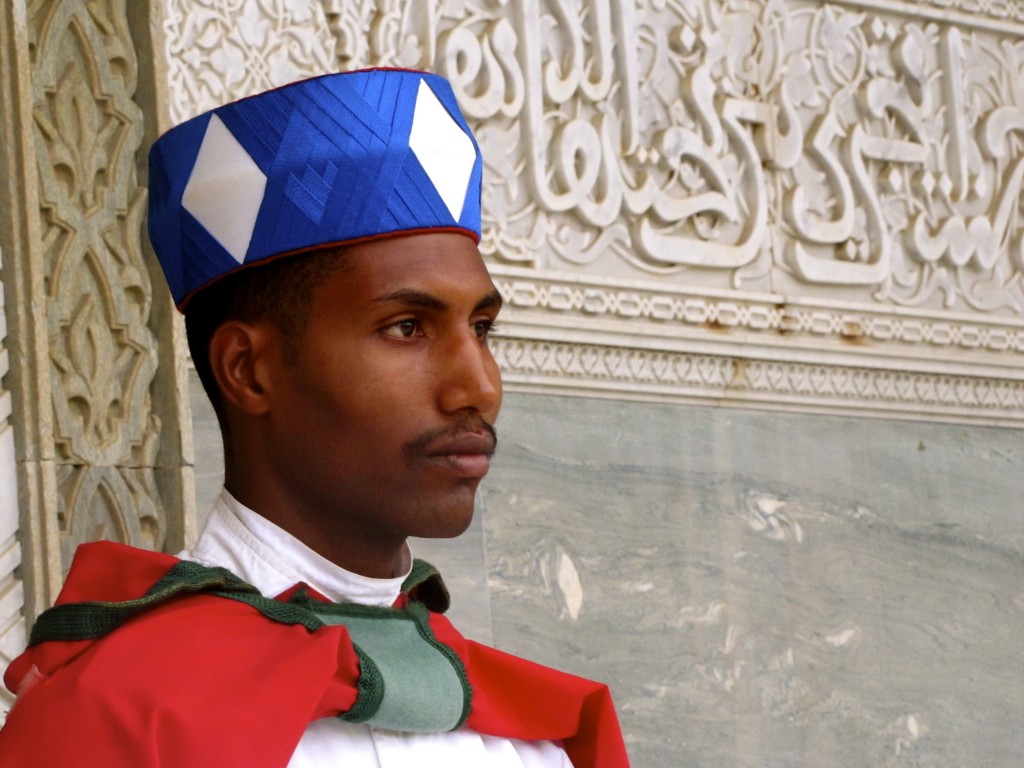
If there was a way, I would give my abroad experience to Kawtar in a heartbeat. With all that she has already accomplished in life, she more than deserves it… I wish that there was a way that I could somehow give every Moroccan that chance to travel. Not just to travel, but to have the freedom to travel. Never before have I felt more blessed to come from the country that I have. In these last few weeks amidst the shut-down, I must admit, I may have not shown the most national pride. However, despite the many faults of our (and every) government, most of us, are blessed to come from a country where getting a visa is not impossible. A country where study abroad is so common that now almost half of all students spend at least one semester away from home. Travel here is not a dream, it is a reality. Next time you find yourself complaining about the security line in the airport or the endless paperwork of a visa, remember that not only are you blessed to have the opportunity to do so, you are also blessed with the freedom to do so.
So go out, explore the world! Even if that ‘world’ is only the pizza place down the street that you’ve always meant to try, but never end up actually eating it. You may find that the place you end up and the people you meet are totally different than yourself, or maybe, just maybe, you will find what I came to know in Morocco. Maybe, we are all much more similar than we give ourselves credit for. Different people born into different economic and cultural situations, yes, but in all actuality, the world you thought was so big and different, might not be so big after all.
Well, it’s been a whole month since I found myself in Granada (very scared, but thankfully not alone) attempting to write a blog post that could effectively express how I was feeling about finally being in Spain. Since then I’ve managed to hold several Spanish conversations with complete strangers, had more than one awkward encounter with my host brother, taken 2 level tests, completed 2 weeks of orientation, explored La Alhambra, traveled all over Morocco, ridden a camel, flown up to Ireland, tasted Guinness, seen the Cliffs of Moher, visited Edinburgh, climbed Arthur’s Seat, saw my first castle, travelled to Seville on a whim, met many new friends, and completed a very successful first week and a half of classes. Whew. So if you we’re wondering about the long hiatus between blog posts, the reality is that my life has been crazy lately. Crazy wonderful, but crazy nonetheless.
Judging by the lack of blog posts, it is clearly evident that I’ve had no problem of adjusting to the “No pasa nada. Mañana…” aspect of the Spanish lifestyle. If you don’t speak Spanish or have never been to Spain, you are now probably staring blankly at your computer screen wondering what the heck you just read and muttering the following phrases to yourself: “Mañana aspect? What in the world are you talking about Marissa?!” Mañana in Spanish means tomorrow. From the moment I set my feet on Spanish soil, I have been bombarded by Spaniards uttering that particular word. Ok, you caught me; that might be a bit of an exaggeration, but the Spanish are quite famous for having the mentality of, “Eh. It doesn’t matter. I’ll just do it tomorrow.” While not one to usually play up stereotypes, this particular one has proven itself to be more than accurate. The people here really are on a totally different timetable than those in the US and the procrastinator in me has been enjoying every single second of it. Need to withdraw Euros from the ATM? Eh, I’ll do it mañana. Need to buy stamps so that postcards can finally be sent? Maybe mañana. Need to update this blog? Mañana.
Mañana. Mañana. Mañana. The unfortunate thing about the “mañana lifestyle” is that mañanas never stop coming. Before you know it a whole month can pass and that thing you meant to do mañana is still written in the “To Do:” section of your planner waiting to be done. With the end of orientation and the beginning of a 19 credit semester has come the reality of a schedule. Even though I am in Spain for this school year, I still have many responsibilities. If I am actually going to get done half of what I want to accomplish while I’m here, I have to stop putting things off until mañana and start doing them hoy (today), beginning with this blog. It might mean sacrificing some of my siesta time, but the upside is that I will start to get done everything I need to.
In the meantime, since I now have almost 4 weeks of things to share, I thought that instead of writing a novel, it would be fun to give you all snapshots of some of the highlights from each day over here so far, beginning with my first week in Granada. Hopefully it will give you a good idea of how much fun I’ve had finding my place in this beautiful city!
After checking out of our hostel and successfully finding our way to Hotel Melia, Amanda, Diana, and I met the rest of the group and our program advisor, Veronica. Veronica gifted us with maps and orientation schedules, our roommates and host moms were assigned, and off we went into Granada! I live with another girl from the program, Amelia, a wonderful casera (host mom) named Paqi, and her 20-something son, Dioni, in an apartment on Ribera de Genil. So far so great!
To begin the day, Veronica and another professor, Aurelio, gave us a walking tour of the center part of the city. It turned out to be a great way to get to know others in the group, as well as begin to learn our way around Granada. Afterwards, we had a quick break for lunch, and then found ourselves back at school for our level test to place us into our orientation groups. The night ended up being a late (but great) one as one of the other girls, Katie, and I braved a pub to stay up and watch Nadal win the US Open.
Today began with another Veronica/Aurelio tour. This time, we climbed all the way up the hills of La Albayzín which are opposite those of La Alhambra. Though we were all huffing and puffing, the area is rich in Moorish architecture/history and offers beautiful views of the city, the mountains, and of course, La Alhambra. After our morning hike, we were officially divided into our orientation groups and began our 3 hour temporary classes.
Wednesday was our first morning without a scheduled tour or activity, so I took the opportunity to sleep in. After a full afternoon of classes, Amelia, Amanda, and I decided it was a good night to go out for churros con chocolate. We walked all along the river, but finally found a place that was still serving them despite the late hour. Apparently churros and chocolate are supposed to be eaten for breakfast here. Who knew?
Before our morning meeting, 2 other girls from the program (who are also staying for the year) and I were faced with the task of hailing our own cab and getting safely to the Office of Extranjeros on the outskirts of the city. We all made it in one piece and with a lot of help from Veronica’s assistant, were able to successfully complete step one of extending our Visas and attaining our Spainish residency cards. Impressively, we even made it back in time for the meeting. After classes, we met our intercambios for the semester (University of Granada students who volunteer to hang out with us and help us practice our Spanish) and went out with them for tinto (red wine) and tapas.
I honestly don’t remember much about this day other than that it was the first time I really took time to walk around the city myself. I let myself wander the streets and get slightly lost, discovering tons of new stores, tapas bars, and ice cream places as I went. Even now, I still have yet to go a day without discovering a new part of the city that I’ve never seen before.
To round off my first week in Granada, the whole group went on a tour of La Alhambra. With Aurelio as our guide, we had an endless stream of historical knowledge at our disposal. Though the inside was beautiful beyond words, my favorite part of the day came when several of us stayed behind to walk in the gardens and Generalife. The gardens were gorgeous and the six of us had so much fun exploring and holding mini-photoshoots anywhere and everywhere. All the new discoveries and new friends made for the best possible end to a fantastic first week in sunny Spain!
I have tried to start this post in so many different ways, but there’s only one way to say it- I’m here in Granada! I still can’t believe it and I’ve been here over a day and a half already. So far the city has been beautiful. The adventure it took to get here, however, was much more of an “I’m going into the African bush with nothing but the clothes on my back” kind-of adventure rather than the “I’m going for a nice camping trip in my RV” kind. What do I mean by that? Well, to be honest, despite all of the emails, google searches, and Spanish grammar review, none of us really knew what we were in for when we got off the plane. I was able to capture most of it in a (hopefully) entertaining video for you all, but to fill in the details before I post it, I’ve written the whole saga down below.
Amanda M.(another girl from Valpo) and I were fortunate enough to run into 3 other girls studying with Central in Granada who were taking the same flight. That was about where our luck ended, however. After getting our luggage and making it through customs in Madrid, one of the girls, Amanda K., and I decided that the next logical step was to hit up the ATMs and get some Euro. There was just one problem. Neither of our cards worked. After a brief moment of panic, we realized we were using the ATM for European cards and not the one for MasterCard/Visa/etc. After switching ATMs Amanda was successfully able to withdraw the amount she needed. My card, however, was still being repeatedly rejected. Thank God (literally) for the other girls. They were successfully able to stop me from bursting into tears and booking the next flight home and reassured me that all would be well. After my panic moment was over, I realized that right before leaving O’Hare I had downloaded an app to my touch that allowed me to make international calls to the US. After purchasing wifi and call time, I was successfully able to call my Waukesha bank. Turns out that even though I notified them of my upcoming travels, they were never put on my record. The bank had thought that someone stole my card to use in Spain and had therefore shut down my account. Luckily, they were able to confirm that it was indeed my trying to use my own card in Spain. All was well and I was able to withdraw my money. *Insert large thank you to dad for convincing me to purchase said iPod here*
Unfortunately, that was only the beginning of many struggles to come. Our program director had sent those of us flying into Madrid a very detailed email documenting all the ways to get from the airport all the way down to Granada. We decided to go the cheap route, which, unfortunately for us was also by far the most complicated. From the airport we bought train tickets. We almost bought the wrong ones, potentially broke one of the ticket gates, and definitely thought we were waiting at the wrong platform for a moment, but in the end, we ended up on the right train. We also ended up blocking off an entire train car because of the amount of luggage we had between the six of us. We managed to get off at the right station, but struggled getting out, because, fun fact, in Spain you MUST save your train tickets and reuse them to open the doors to exit the station. It’s a great way to ensure that everyone pays their fare, but it’s not so great when you’re an ignorant American student who has no idea about said system. Thankfully we all made it out.
Finally out of the train station, we were ready to conquer the world that is the Madrid bus station. We were able to find the right bus company fairly quickly, but found out that we had just missed the early bus and were going to have to wait for 2 hours to catch the next one. Excellent. We were able to successfully talk with several Spaniards while we waited and even learned the meaning of the mysterious “tío/tía bueno” expression we had been hearing (for those of you that don’t speak Spanish the expression literally translates to good uncle/aunt. Apparently in Spain that’s what they use to describe good-looking people. So confusing, but hilariously and graciously explained to us by an older Spanish woman). The 2 hours actually flew by and before we knew it we were boarding the bus.
Right before we got on, I spotted another college-age girl also sporting a huge suitcase and a Vera Bradley duffel (usually a pretty dead give away that one’s American). She came up and asked if I was also going to Granada, and turns out she’s a Central Abroad student too! After that crazy chance encounter, I settled in for the 5+ hour bus ride to the south of Spain. I missed the entire first 2ish hours of the ride catching up on sleep, but from what I saw of the last 3, the Spanish countryside is beautiful! I’ve never actually seen mountains before in my life, so being able to drive straight through the Sierras was incredible. The foliage here is so interesting. I can’t wait to take advantage of all the hiking around Granada and climb some of these mountains myself!
Anyways, we arrived to the bus station on the outskirts of Granada safely and without much event. Once again though, we had a little trouble figuring out which form of public transportation we should try next. When given the option between a city bus and taxis, we decided to take the “easy” way out and grab a cab. Diana, Amanda M., and I were staying in a hostel vs. The Hotel Melia Granada like the rest of our group, so we took a separate cab. Though the hostel was right behind the famous store Zara, only a few blocks away from Hotel Melia and should’ve been relatively easy to find, our cab driver mistakenly left us off 2 blocks early. Luckily, the owner of another hostel was able to point us in the right direction and we made our way safely there- heavy luggage and all. Even better, the woman and her husband who own the hostel are AMAZING. They took such great care of us! If any of you are thinking of coming to Granada (You all should!) and need a cheap place to stay, Old Town Hostel is literally the best money can buy. €12 for a night’s stay, a hot shower, breakfast, and a rooftop terrace. You can’t beat it.
To say the trip was long is an understatement. I definitely had more than one moment of, “What in the world am I doing here?! I can’t function here for one day, let alone an entire year!” but being in Granada and meeting the other girls made it all worth it. Amelia, the girl we ended up meeting on the 2:00 bus, because we missed the first one? Turns out she’s my roommate for fall semester! She’s also a huge answer to prayer, but that’s a story for another blog post. For now, I need to head to bed. Tomorrow we see more of the city and take our first level test. *Gulp* ¡Hasta lluego!
In exactly two weeks, I’m going to be sitting, (very jet-lagged), in my own living room with my parents and sisters, watching American TV, eating my mom’s cooking, looking out the window at my own backyard in St. Charles, Illinois. And it’s absolutely mind-boggling. It feels like a week ago, I was on board that 8-hour plane ride across the ocean, turning knots in my stomach because I honestly had no idea what I was getting myself into. “Terrified” hardly begins to cover how I was feeling back in January, and now that my time abroad is winding down, I’m looking back on that earlier, timid version of myself and feeling an overwhelming sense of personal accomplishment about the person I am now. Studying abroad has given me the key to finding within myself a personality trait I never knew I had: bravery. For someone like me who used to live in constant (sometimes obsessive) worry, that’s something of a miracle.
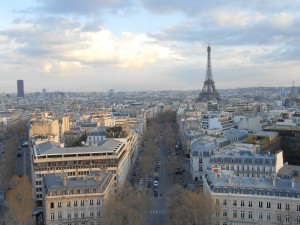
In a world where there's so many acts of terror and fear, it's a blessing to remember that there are also so many examples of incredible beauty out there.
Just so you know, this blog post is about to get very serious. However, I think it’s an important thing to talk about, because my personal experience abroad has related so strongly to this topic. In light of what happened in Boston two weeks ago, I’ve been reflecting a lot on the awful, crippling power that fear has over human beings. It amazes me how a single act of terror can transform the way the entire world looks at society: Americans aren’t the only ones who were affected by the Boston Marathon bombings. Airport security around the globe has tightened. I’ve received e-mails from the Spanish Embassy in Madrid to be extra vigilant in my day-to-day routines outside of the house. My host mom just about had a heart attack when I wasn’t home from school on time the other day because I was talking to my professor after class. People everywhere are treading on eggshells around one another, trusting each other a little bit less than they did before, all because of the spell that terror has cast over this world.
It’s all for good reason, and I can certainly say that my guard is up a little higher than it was two weeks ago. The scary reality is that there is no place that is truly safe from unspeakable tragedies, and there’s always going to be people out there who seek to stir up our deepest and most paralyzing personal fears. Not so long ago, I used to view the world around me from that point of view – constantly letting worry get the best of me and fearing the worst of humanity. I called myself a “realist” because, let’s face it, all of these terrors are very, very real. What I didn’t know at the time was that being a realist can coincide perfectly with being an optimist, and that choosing to seek the good and the beautiful in this world is the recipe for finding courage in the face of fear.
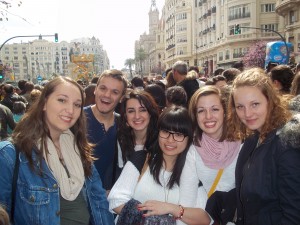
Getting out of your comfort zone, making friends from all over the world, and learning from them is one of the best parts about living abroad!
The thing about studying abroad is that it has the power to truly force you out of your comfort zone if you let it do so. Get out of your room and just go take a walk by yourself without a map. Strike up a conversation, no matter how bad your Spanish is, with the lady waiting with you at the bus stop. Watch a movie with your host family, even though half the dialogue goes over your head. Go to the bars (don’t be stupid about it), and meet people. Try that weird food. Navigate a bus system that you’re unfamiliar with. Travel to a place where they speak a language you will never learn. Learn from people who don’t come from the same place you do, and teach them new things as well. These are all choices, and a lot of them will make you uncomfortable. But with each baby step out of your comfort zone, you start to learn that there’s beauty and light in this world that you never saw before. Before you know it, you’re taking leaps and bounds out into the big wide world, and discovering the courageous person that lives inside of you.
We’re called to live boldly, to seek the best in people, and to overcome the fear that acts of evil can instill in our hearts. It doesn’t mean to be careless, but rather to choose courage over worry. One of my thematic Bible verses of this semester has been 2 Timothy 1:7 – “ For God has not given us a spirit of fear and timidity, but of power, love, and self-discipline.” It’s a nice reminder that we’re not alone in this world, and if we can choose to see things in a different light, we might just be amazed at how easily the beauty that surrounds us can overcome the darkness.
Since coming to Spain, I’ve learned all kinds of common conversational phrases that we just don’t have the proper words for in English. Yes, if you put them into Google translator, you’ll get some kind of ballpark answer that gives you an idea of what the phrase means. For example, if you take the title of this post and copy it into the translator, you’ll get the response: “you take advantage of.” Que aproveches is one of my favorite Spanish phrases, and considering the fact that I only have 17 days left in this amazing country, it’s a very appropriate thing to be saying during my final stretch here. That being said, Google’s response to que aproveches does not do the phrase any justice whatsoever. It’s something you say to someone else before they enjoy one of the finer things in life: an excellent meal, a night on the town, a vacation, a bottle of champagne, or (in my case) the last few days of the adventure of a lifetime. To me, que aproveches means “I hope you get the most out of it – that you enjoy every last fraction of a second to the very fullest and that you savor it for all its worth.”
Nobody takes this phrase to heart quite like my good friend, fellow Valpo student, and traveling companion, Kevin Miller. Back in February, we read an article in class about a tradition that dates back to the middle ages: a cross-country pilgrimage known as the Camino de Santiago. Beginning as a religious journey towards the destination of what was once considered “the edge of the world” (the Cathedral of Santiago de Compostela on the westernmost coast of Spain – where the apostle James is buried), the Camino has been traveled over the centuries by millions of “pilgrims” from all over the world. After learning about this tradition in class, Kevin mentioned that he’d really like to try it. Last week, that’s exactly what he did. Kevin wrote a little bit about his experiences for us to read, and gave me some photos from his journey to post here…
“It’s dubbed El Camino de Santiago (The Way of St. James), but in reality, it’s a network of many different routes that all converge at the destination point of the pilgrimage, the Cathedral of Santiago. I spent seven days biking on the Camino Frances, which begins in St. Jean Pied de Port, a small French city only a few kilometers north of the Spanish-French border. I began my journey in Pamplona, which is about 100 kilometers from St. Jean Pied de Port, and finished at the Cathedral.
Most pilgrims do the Camino by foot, normally walking from about 8am until sometime in the mid afternoon, where they then find a shelter where you can shower, get some dinner, relax, and recharge for the next day. But some, like me, decide to do it by bike (and even some, although I didn’t see on my trip, by horse!). Naturally, the Camino Frances is a nearly perfect east to west route. Therefore, each day the sun served as my guide: creeping up my back, illuminating my helmet, and then sneaking down my front side before sending its last few rays over the distant horizon.
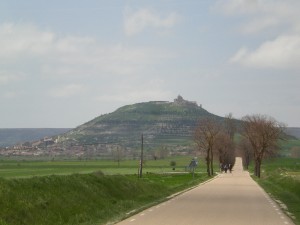
Kevin's view along the Camino (notice the other pilgrims ahead on the road) while entering one of the many pueblos along the way.
The Camino attracts people from all of the world, all doing it for some particular reason, whether for religious or spiritual motives or solely for the adventure. During my journey, I spent time talking with pilgrims and Spanish locals, either in the shelters in the evenings or during the day when I felt like substituting my biking legs for walking legs. I met an economist from Denmark, a Venezuelan software engineer, a construction worker from San Sebastian (northern Spain), a mother and son from Alabama, a Belgian architect, a truck driver from A Coruña (northwest Spain), a Canadian medical technician… the list goes on and on. It was quite a beautiful experience, and if any of you reading this have the opportunity to do it, I’d recommend it. You certainly won’t regret it.”
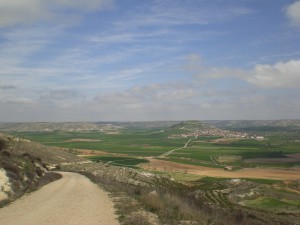
The view of the Camino from the top of one of the hills that Kevin climbed up - looking back to the east.
Kevin’s unique journey across the country of Spain is just one of those things that resonates so appropriately with the concept of aprovechando. Taking advantage of every opportunity, every adventure, and savoring those moments to the fullest are such important aspects of studying abroad, and are things that can only be learned through taking a leap of faith into those types of journeys. It’s a way of thinking that I’m blessed to be taking back home with me. I know without a doubt that all students who have been abroad can easily say the same after experiencing their own individual leaps of faith, savoring the details of such journeys with a new found sense of what it means to take advantage of the moments we’re given.
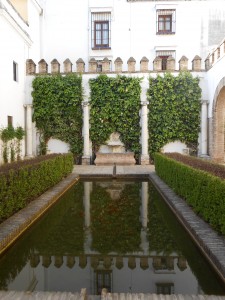
One of the many patios within the Real Alcázar, which was once a Moorish fort/palace. See the fishies in the reflection pool?
Okay, before I get started here, I’m going to warn you. I’m about to sound like a travel agent who’s sugarcoating everything in order to close a deal. I promise you, none of this is an exaggeration. Southern Spain is a world entirely of its own, and for lack of a better description, it’s magical. The air is filled with the smell of orange blossoms and the sounds of street musicians playing flamenco guitar, the sun shines in a bright blue sky until 8 pm. Wrought-iron balconies spill flowers out into winding narrow streets, ornate ceramic tiles adorn every door frame, and the clock slows down to match the laid-back, fun-loving lifestyle of the south. Words and pictures don’t do it justice, it’s just something you have to feel… but it exists and it’s definitely magical.
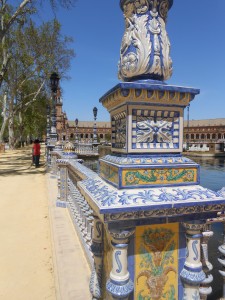
Ceramic tile work outside the Plaza de España. This kind of detail is part of almost every building in the city.
Seville is a city steeped in a rich and diverse history. Thus, its culture has developed over the centuries into a beautiful mix of flavors that is entirely unique to the south of Spain. Conquered by first the Romans, then the Moors, and then the Jewish and the Catholics, the city shows evidence on every corner of how it has aged and evolved over time. Take, for example, the Roman wall that surrounds the city center. After the Romans left, parts of the wall were incorporated into different structures, serving as a supporting wall of the Real Alcázar (one of my favorite places in Seville, a Moorish palace that is filled with acres of incredible gardens and patios), or even being built into houses. There are a number of houses that were built right onto the wall throughout the Moorish and Catholic reigns that still are inhabited today, covered in the intricate tile work common to the Moors and the close influence of Morocco and North Africa. And yet, they bear the family crests from the 1500s-era Catholic families that lived there centuries ago. This type of culture-blending is evident everywhere you look in Seville, and has since become a trademark of the city’s flavor.
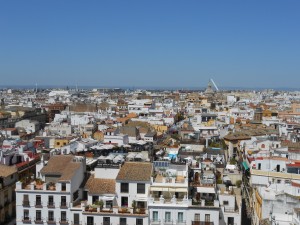
The breathtaking view of the city from the top of La Giralda, a 34-story tower attached the the Catedral de Sevilla.
The architecture isn’t the only thing about Seville that serves as a distinctive symbol, though. What brings the real magic to this city isn’t the buildings, but the people and their customs. The home of Flamenco, Sevillianos take their music, dancing, food, drink, and parties very seriously, and everything else kind of happens by its own time. Siestas are an even bigger deal here than in Zaragoza, and nobody’s ever in a rush (unless they’re talking. Understanding the Andaluz accent at the speed with which they talk was next to impossible!) I got hooked on the beauty and tradition of Flamenco while I was there, thanks to a few factors: trying on a traditional gown (I felt like a human Barbie doll!), watching a Flamenco dancing show over a pitcher of sangría, and perhaps most importantly, the buzz in the air regarding the upcoming Fería de Abril.
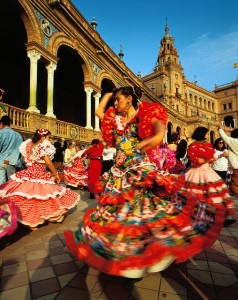
Alright. Obviously not my picture, since I missed the Fería. But this is what it looks like and is the reason why I was so enchanted.
The Fería started this past Tuesday, and is essentially a week-long dancing, eating, drinking, and socializing
extravaganza. At the edge of the city, they set up 1000+ massive tents, called “casetas”. Each caseta is an exclusive access facility, and you can only get in if you know a member (one of the group of people who are paying for the caseta to function at the Fería). Thus, it’s not unheard of for someone to be on the waiting list to be a caseta member for 30+ years. In each caseta are a bunch of tables, a dance floor, and a bar. Each day at the Fería, women dress in traditional Flamenco attire, and men will wear suits and ties. Dancing is a big part of the event, and the “Sevillana” style of dress, music, and dance dates back to the 1700s. We didn’t get to see the Fería in action, because we left Seville on Monday morning, but we did get to go to the fairgrounds and saw a caseta, thanks to a friend who has been living in Seville for six years.
One of the things I love most about Spain is the way that the Spanish have done such a great job preserving and celebrating their roots. Nothing gets washed away by history… the past is beautifully blended into the present in all aspects of life: culture, architecture, food, lifestyle. Seville is such an explicit and colorful example of that phenomenon, and I’m never going to forget the unending beauty of it all, and the way it swept me away to the point of being unable to convey it in words. I think this is my longest entry to date, and I’m still frustrated that my pictures and descriptions don’t do it justice. Guess that means that you all just have to find an excuse to go there and see for yourself…
Who’d have ever thought that I’d wish for a translator while speaking my own native language? Despite the fact that the British speak English, there were so many instances during my ten-day excursion to the UK in which I felt like I was listening to a completely foreign language. Okay, maybe that’s a BIT of an exaggeration. But when pants are “trousers” and underwear is “pants”, or when potato chips are “crisps” and french fries are “chips”, (not to mention the fact that everyone drives on the other side of the road), it’s not hard for a Yankee to get a little confused.
All joking matters aside though, I truly fell in love with England during my time there. As was the case with my trip to Belgium back in February, I’m incredibly fortunate to have family living in Leicester (a city about two hours north of London) who took me in with open arms, and gave me the full “British Experience.” If you’re wondering what that entails…
-
Fish and chips, more Cadbury’s chocolate than I care to admit, a number of English ales and ciders, pork pies, sausage rolls, crumpets, scones, and lots of tea
- Taking a day trip to Oxford, where we saw the gorgeous University buildings, took a tour on an open-air double-decker bus, and walked through Christ Church… also known as the set of the Great Hall from the Harry Potter movies
- Spending a day at a refurbished medieval castle, climbing hundreds of stone steps and taking in the amazing views of the English countryside from the tops of the towers
- Participating firsthand in the Grand National horse race (everyone in the family bet one pound on a horse, and my cousins took me to the “bookie” to place the bets before we all watched the race together)
- Exploring the old English countryside, where one of my cousins grew up amidst the endless miles of sheep farms, centuries-old stone churches, boating canals, and of course, the classic old-fashioned neighborhood pub
Along with all of that, I got to spend four (chilly!) days in London, which (despite the weather) was endlessly beautiful to me. I’ve heard from a number of people who have been to London that it’s a city you will either hate or love, and it is with great confidence that I can say that I’m part of the latter group. I don’t know how anyone could find it to be a disappointment – there’s so much rich history, distinct culture, and exciting energy buzzing in the air there. Not to mention the fact that my London experience was highlighted by a fantastic reunion: I met up with my good friends Becca and Dia, who are currently in the Reutlingen, Germany program. We spent our time together covering every last corner of the city on foot, from the River Thames to Buckingham Palace, accompanied by lots of Cadbury’s chocolate, peanut butter and honey sandwiches (nothing like living on a college kid’s budget!) and the joy of catching up and swapping travel stories.
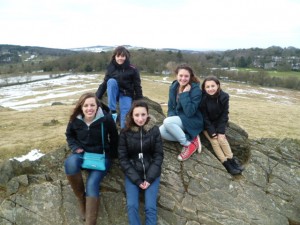
Last time I saw these guys, they were all babies! It was so wonderful getting to reconnect with them.
Though the unique range of traveling I had during my stay in England was vast and punctuated by dozens of fascinating sights, I think the overall theme of my journey in the UK was the wonderful experience of reconnecting. Getting to spend time with my friends from back in Valpo while in London was like a breath of fresh air – there’s nothing like picking back up where you left off with old friends. On the other side of things, I haven’t seen my British family in twelve years, and going to visit those cousins was like receiving a long-overdue gift. Along with the many adventures that they took me on, I’m never going to forget the “regular” moments: sitting around the dinner table telling stories, poring over old photos of my grandparents, parents, and 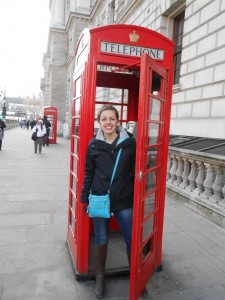 other relatives when they were young, playing on the Wii with my younger cousins (in the picture on the right), or my daily “British vocabulary lessons”.
other relatives when they were young, playing on the Wii with my younger cousins (in the picture on the right), or my daily “British vocabulary lessons”.
In all, this trip was a wonderful gift, and I’m “well chuffed” that I was able to experience all the things that I did. Years from now, just the thought of England is going to warm my heart with dozens of happy memories of family, friends, and adventures. I’m so blessed, and England was just another example of the many reasons I have to be thankful.
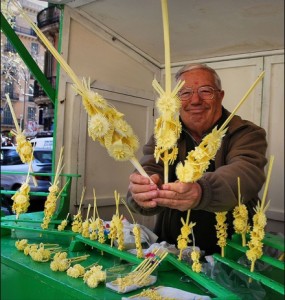
On Palm Sunday, street vendors all over Spain sell elaborate palm sculptures. They're a big hit with the local children!
Every once in a while, there’s a moment when I realize just how American I am, despite the fact that I sometimes like to convince myself that I’m slowly becoming Spanish. For example, yesterday in class, we were discussing Easter traditions. It was pretty funny when we tried describing the purpose of the Easter Bunny to our international classmates and our Spanish professor, and honestly couldn’t find a real reason why we celebrate Jesus’ resurrection with a giant, egg-bearing rabbit. Luckily, though, America isn’t the only nation that celebrates this time of year with traditions that seem a bit strange to other cultures. Some of the primary elements of Spain’s take on Easter are equally (if not more) surprising, especially when seen through American eyes.
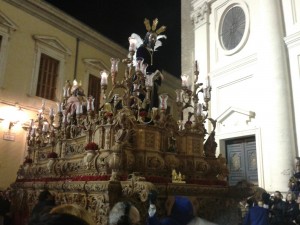
The Paso depicting Jesus being led to Pilate by the Romans. It was carried from underneath on the necks of around 30 people.
Being a nation that declares itself primarily Catholic, one of the most important weeks of the Spanish calendar is the Semana Santa, or as we know it in the States, Holy Week. The seven days leading up to the resurrection of Jesus Christ are celebrated much more publicly here than they are in America, and range in extravagance depending on the region of the country that you’re in. For example, in Zamora (central-northwest Spain), members of religious brotherhoods can be seen throughout the week re-enacting the crucifixion of Jesus or performing public acts of penance, complete with wearing shackles and wailing in the street, until Easter Sunday. In Málaga (southern Spain), the week is much less somber, often filled with flamenco music, tourists, and cause for daily celebration. Zaragoza’s Semana Santa is more of a “happy medium” between the two extremes, and is a good representation of what a generally traditional Spanish Semana Santa consists of.
Throughout the week, there are a number of massive processions consisting of anywhere between 100 and 400 people that wind through the streets and draw huge crowds. The grand jewel of each individual procession is the Paso: an expansive, heavy wooden float depicting either Jesus or the Virgin Mary (or both), usually covered in flowers, beads, candles, and rich fabric. Sometimes these tributes to Christ are rolled on wheels, but other times they’re carried from underneath by large groups of local men, who rest the burden on the backs of their necks as a representation of Jesus carrying his cross to Calvary. The Paso is usually accompanied by different groups of people involved in the procession, including priests bearing incense, trumpeters and other brass instrumentalists, and of course, hundreds of Nazarenos.
This is the part where I get to explain what I meant earlier about how there are just some Spanish Easter traditions that will always seem strange to an American. In fact, if you don’t know much about the history and significance behind the Nazarenos, you’re likely inclined to find them downright terrifying. In the bluntest of terms, they look eerily like more colorful members of the Ku Klux Klan, and seeing them gave me a serious case of the heebie-jeebies. Usually made up of members of a religious brotherhood, the Nazarenos march in the processions during the Semana Santa cloaked from head to toe in tunics and capirotes, (pointed hoods that cover their faces entirely and only have eye holes cut out) as part of a tradition that dates back to the middle ages. The purpose of the KKK-esque getup was originally to show reverence for Christ’s crucifixion without glorifying their individual identities, and it’s still continued in that manner today throughout the country.
The procession of the Nazarenos into the Catedral La Seo (Click here)
The majority of the Nazarenos play a forceful drumming routine as they proceed throughout the city, and it’s both a haunting and intriguing thing to see in person. When I got to witness a number of these processions on Sunday, I was with one of my friends who has lived in Zaragoza all of his life, and he kept cracking jokes about how much the Nazarenos scare Americans. (He also taught me the majority of the information that I put in this post… so thanks for the education on the Semana Santa, amigo!) Overall, if I took anything away from learning about the Semana Santa, it’s how amazing it is to really take note of the meaning behind tradition. For example, it’s crazy to see that something SO offensive and negatively associated in the States (like the pointed hood of the Nazarenos) is considered to be a sacred, incredibly important historical and religious symbol elsewhere. Just one more example of how fascinating cultural differences can be, from the Easter Bunny to the streets of Spain, and everywhere in between.
Hundreds of thousands of people filling the streets. Bottle rockets popping and screeching on every corner. 30-foot-tall statues that look like they wandered out of cartoons. The smell of churros drifting from striped tents and of paella coming from restaurants. Kids running around with sparklers. Dozens of parades made up of people dressed in traditional Valencian clothing. A midday pyrotechnic show that shakes the very earth beneath you. Plazas filled with music, and people dancing late into the night underneath a sky full of fireworks. Put it all together, and you’ve got the festival of Las Fallas. Throw 165 international students who are studying in Zaragoza into the mix, and you’ve got an amazing whirlwind of a day that will live on in my heart forever.
Las Fallas is a massive five-day festival that takes place each year in Valencia, on the northeast coast of Spain (about a 4 hour bus ride from Zaragoza. We packed three buses full of students to go down to enjoy the celebration!) The festival celebrates two key events: the beginning of Spring and the celebration of Saint Joseph, (the carpenter who was Jesus’ Earthly father). It’s essentially a pyromaniac’s dream – the name “falla” derives from the Latin word for torch, and the celebration certainly lives up to the name. Not only does the sound of firecrackers continue endlessly throughout the city from dawn till dusk, but the 30-foot-high statues (called Ninots) that are created by each neighborhood during the course of the year are burned as a symbol of cleansing and deeply rooted tradition. During the middle ages, at the start of the spring equinox, farmers would burn the old wood from the winter in large bonfires. Over the centuries, the tradition has evolved into the construction of the elaborate Ninots, many of them with political or historical themes. It’s kind of a shame that they burn them, in my opinion, because many of the Ninots are incredible to look at. However, during Las Fallas, the city of Valencia essentially becomes a hub for dozens of massive bonfires, and it’s a spectacle that’s anticipated all over Europe as one of the most unique and breathtaking celebrations in Spain.
Along with the Ninots and the stunning pyrotechnics, the traditional element of the celebration that I found to be most beautiful were the miniature parades that wound through the city during the better part of the afternoon. Made up of anywhere between 10 and 100 people, these little processions are composed of men, women, and children dressed in traditional Valencian clothing from different important eras in Valencia’s history. Each outfit is unique, and appears almost as its own work of art. The parades are tailed by small groups of drummers and trumpeters, and could be heard and seen on every street in the city during the hours before sundown. The dresses especially reminded me of the kind of thing you might see a Disney Princess wearing (if there was ever a Spanish Disney Princess), and just added an extra dose of fantasy to the already dream-like atmosphere of the festival.
I think what I love most about festivals (because, as I mentioned a few weeks ago, I also fell in love with the Fiesta de San Valero in Zaragoza) is the way in which the community rallies to celebrate together. Yes, we do have our holidays and celebrations in the United States, but there’s something in the air here that is so rich and invigorating, and it buzzes throughout the people in the city with an energy all of its own. Maybe it’s the element of larger-than-life fantasy, or maybe it’s the tradition. Maybe it’s just the fumes from all the sulfur in the fireworks. Either way, Las Fallas especially has got a life of its own, and it’s beautiful to be a part of. Tourists from all over the world walk side by side with locals, thousands of people of all ages and races marvel together at the sights, sounds, and smells of it all, and for just a moment, you’re allowed a glimpse of a world in which our differences are overlooked and we are simply allowed to enjoy the beauty of community and tradition. It’s a deeply moving thing, and is an experience that I am so grateful to have had alongside my friends from all over the globe.
© 2025 Valpo Voyager
Theme by Anders Noren — Up ↑

